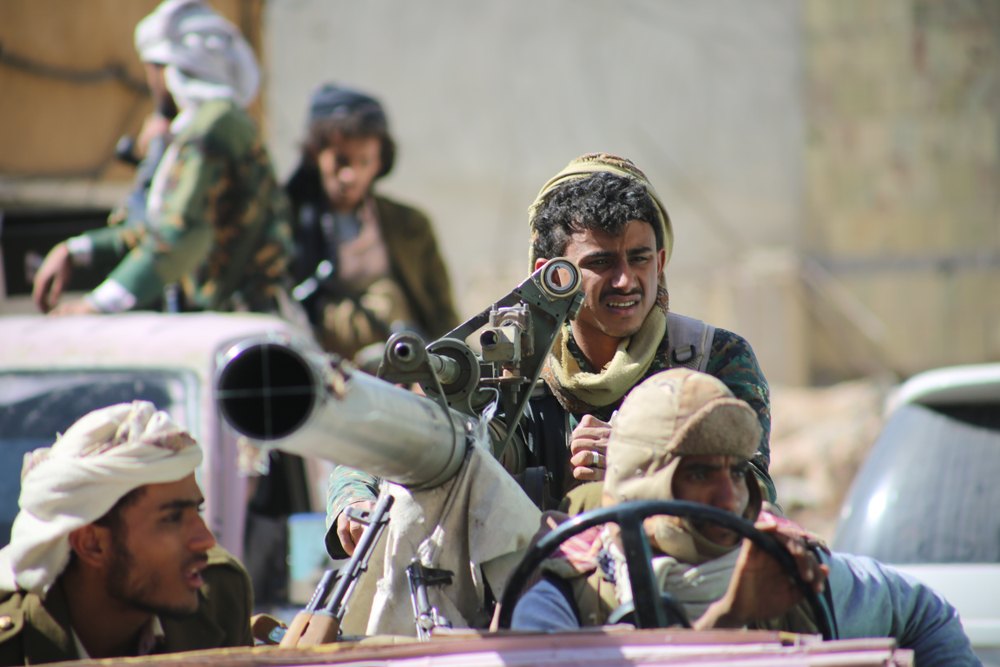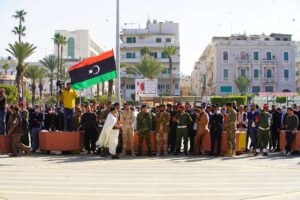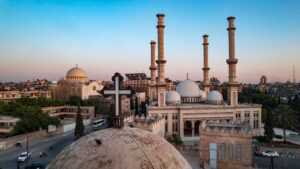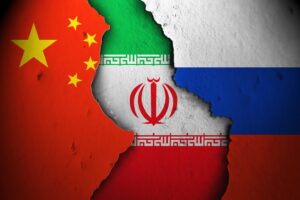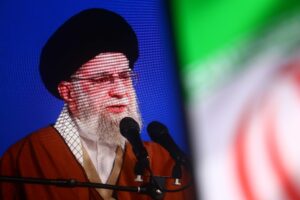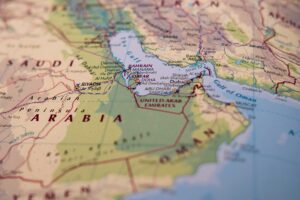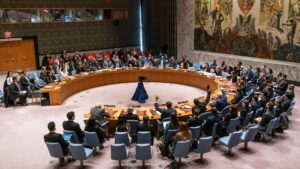The fraught political transition between 2011-2014 in the lead to the war in Yemen was riddled with complexity and missed opportunities and led to the plight of 29 million people. We were again reminded how fragile and complex political transitions can be, even in the more proficient democracies, during the recent presidential transition in the USA.
It has been ten years since the impulsions of the ‘Arab Spring’, when upheavals based on rights and inequalities led by youth and women on the streets of Yemen and other Arab States brought about a little hope. With this hope came a level of complexity: the international community wished to maintain the status quo. This strategy has proven to be a driver of complexity, further state fragility of state, and pushed millions of Yeminis into near famine. It is this status quo [i]that has allowed the conflict to ravish and challenge the existence of what was already a fragile state with over 14 million in need of humanitarian support in 2014.
Today starvation, disease, and war are ravishing Yemen. All driven by the multitude of factors at a community, national levels with dynamic drivers underpinning insecurity, chaos, and economic collapse. While systems and structures at a regional and global level fail to protect the Yemeni people, who are arguably the country’s main commodity, providing a fruitful workforce for the Arabian Peninsula[ii].
Millions are falling into the hunger trap with children and women taking the brunt[iii]. The gruelling tit-for-tat of elite bargaining and UN shuttle diplomacy to preserve Yemen’s centralized system is failing. So why do we continue to follow the same approach? Why is power-sharing still discussed as a way forward for a country that has never seen power-sharing work before?
Meanwhile heading towards the seventh year of war, the Government of Yemen, who spent most of the past six years, sitting in Riyadh guiding and legitimizing a regionally led assault to recapture the capital city of Sanaa. But, for the southern port city of Aden, it has failed to provide basic services and fulfil the needs of those in the areas that it now has control over, both in the north and the south of the country. Sanaa, Yemen’s capital city, was captured by the Houthis, a group now in control of Sanaa and most of the Northern Highlands of Yemen. Over the past six years they have set up parallel structures upholding the status quo and continuing total control and governance of the northern parts of the country.
The Fiasco of Elitism: Yemen’s Fragmentation and Somalisation
For many years, one opportunity after another had been missed to stop this crisis from unfolding with international efforts focused on the notion of elite bargaining and reaching a power-sharing agreement.
For many years, analysts had predicted that Yemen would face high levels of hunger and, with depleting water levels,[iv] the country will face more challenges than opportunity. But, for many years, one opportunity after another had been missed to stop this crisis from unfolding. With international efforts focused on the notion of elite bargaining and reaching a power-sharing agreement – an approach that many Yemenis, analysts and politicians have advised against for years – the status quo vision has led to the downward spiral of Yemen that we see today.[v]
With a mostly rural population[vi], with little education, Yemen unexpectedly joined the Arab uprisings of 2011. The Arab Spring gave hope to youth as well as women in Yemen. There was a sense that youth are making history to save a failed unitary state which prompted three major questions: What will transition look like? How would Yemenis absorb the loss of life and provide justice? And will transition deliver a long-term vision for a better Yemen?
Thirty-two years of authoritarian rule had already led to the demise of state institutions both in the south and the north of the country, which led many in 2014 to predict famine and hunger reaching levels never before in Yemen’s history. In response, a Gulf Cooperation Council (GCC) agreement [vii]kept the same authoritarian regime intact, as the West wanted leaders supportive of its actions against a handful of people in al Qaeda. The institutional weakness of the GCC secretariat that was observed between 2011-2014[viii], rapid changes in leadership within the region, the political jousting between gulf states that ended with Kingdom of Saudi Arabia (KSA) and the United Arab Emirates (UAE) severing diplomatic relations with Qatar, compounded the difficulties of negotiating a comprehensible regional approach to ending the conflict and achieving a ceasefire as proxies competed for power on the ground.
The GCC brokered an internationally backed yet fragile process aimed at achieving the peaceful transfer of power from President Ali Abdullah Saleh to his Vice president Abdu Rabbu Mansour Hadi. Hadi, then the sole candidate in an election that aimed to clear the air and create space for peace, won in a landslide election with above 80% of the vote just like his predecessor did for decades before him. Consequently, the status quo was preserved.[ix] Backed by western donors and the GCC, a wide-ranging National Dialogue Conference (NDC) was created to solve Yemen’s political woes.[x] It had an explicit mandate for women and youth to actively engage in the transition process. While Yemeni youth and women played an integral part in the 2011 uprising and joined the NDC discussions, many have since argued that their voices have been marginalised by the political elites despite the imperative of civic engagement and representation in the NDC[xi].
An internationally recognized forum called the Friends of Yemen was in place to discuss accountability with the Government of Yemen and Saudi Arabia. [xii]Through this forum, the Yemeni government was supported in its efforts to develop a transitional plan for stabilization and development. An even more ambitious accountability framework [xiii]was envisaged, setting out high ambitions but, critically, with no capacity to deliver while corruption threatened outputs of any financial investment. Since the escalation in war in March 2015, the space for solutions, both at the national and international levels, to think about or even develop what a transition could look like, was dramatically reduced. This was worsened by the evacuation of most embassies and international donors along with the departure of the delegation of the UN Envoys Office and GCC delegation in Yemen who negotiated and supported the development as well as funding of these ambitious plans.
It was the failure to agree on the structure of State, a new constitution, and fiscal justice that led to Yemen’s total collapse. Once again, the question arises as to why was the status quo the only solution? The political showcasing and staged transition continued into 2014, but after months of negotiation delegates of the NDC committed to the transformation of Yemen into a federal state[xiv]. In September of that same year, the Houthis, a marginalized group from the far north of Yemen who had taken part in the revolution in 2011, advanced on Sana’a holding proudly an anti-corruption banner disputing a dramatic increase in fuel price caused by a retraction of fuel subsidy. [xv]The Houthis were now in an unofficial alliance with the ex-president Saleh, which resulted in a military coup and ousted the internationally recognized government (of President Hadi) which was put in the first place to deliver this now impossible transition process. This culminated in Saudi Arabia leading a coalition, backed by the UK, USA and others in the west, to intervene militarily in March 2015.
Does Yemen need policy or substance?
Yemen's population largely depends upon remittances, public salaries, pensions, and a fragile welfare payments system introduced following the retraction of subsidies of key commodities.
Yemen is highly dependent on imports of fuel and food with the country importing 90% of all food commodities. The population largely depends upon remittances, public salaries, pensions, and a fragile welfare payments system introduced following the retraction of subsidies of key commodities that kept food affordable in the 1990s. The country exhausted its water and oil resources with predictions, in the 2000s, alluding to major population movements from urban centres in the northern highlands have become true[xvi]. Despite its extensive access to sea water, desalination and investment in renewables hardly received any consideration.
With insufficient agricultural land to feed its growing population, Yemen was encouraged to use its oil wealth to import expensive foodstuffs such as wheat and rice. In the 1980s central policy led the elites to undercut the local producers of wheat, pushing many farmers in the heavily populated northern highlands to shift to growing cash crops or giving up altogether; in the south, poor agricultural policy and management simply left many farmers without work. The little oil and gas income enabled the government to provide heavily subsidised fuel, which artificially reduced the cost of water and benefited elites disproportionately. It also allowed the pumping of water from deep wells for drinking and farming. [xvii]Today, with the threat of climate change and virtually no climate adaptation policy in place, who knows what the future holds?
Regular shortages of fuel and delays to welfare payments and public salaries became a common occurrence. Instead of fuel subsidies, donors urged a rapid expansion of the social welfare system to better target the needs of the poor. Unfortunately, this involved removing thousands of richer Yemenis, replacing them with poor Yemenis who have been waiting to receive social welfare for years. The donor remedy wasn’t working as Yemen continued to borrow until it had no choice and removed the fuel subsidies overnight. Even today, without a medium-term strategy and vision, will the people of Yemen ever find a way to establish a working social protection system that protects a minimum standard of living?
Since 2015 the relocation of and the poor functioning of the central bank led to reduced private sector confidence, which in turn negatively affected the exchange rates that consequently affected those who depend on remittances.
The multitude of market shocks, instability, and reduced purchasing power led to increased food and fuel prices. Since 2015 the relocation of and the poor functioning of the central bank led to reduced private sector confidence, which in turn negatively affected the exchange rates that consequently affected those who depend on remittances. In 2012, KSA injected $2billion into the Central Bank of Yemen to ensure the economy kept afloat. The country was now no longer able to import without support from the international community. In 2014, KSA injected a further $1.4 billion to support social welfare payments and food imports. KSA and UAE continued this support throughout the conflict sending billions of dollars in grants, loans, and oil shipments to re-float the economy thus effectively paying Yemen’s food bill. Since the escalation of war in 2015 importers incurred extra charges owing to delays, fees that are in turn passed on to consumers in Yemen at inflated prices of food, fuel, and water.
In 2017, Yemeni government officials were quoted as saying that KSA promised $10 billion towards the reconstruction of Yemen. While this money did not materialise, KSA and the international community continued to pump funds with a further $2 billion to support food imports from the KSA and billions into the Yemen Humanitarian Appeal led by the UN. While aid operations previously helped nearly 14 million people every month, that number has plummeted to just over 10 million as funding is cut and reduced. Although it must be recognised that aid money has been a relief to millions, arguably aid can only account for 10% of needs. While aid and the generosity of Yemen’s neighbours and friends in the international community have proven to save lives and support those most marginalized and in need, questions are never far or in-between about the levels of corruption, illicit funds, and capital flight. Is corruption a killer or is it just the status quo in Yemen?
Many in 2014, perhaps uncritically, thought of the (Arab Spring) revolution as a ‘success’. But they ignored the increasing poverty Yemenis faced. Solutions for Yemen by Yemenis took a back seat; they were ignored in favour of a western exported foreign policy and the status quo. Meanwhile the humanitarian situation in the country is worse than ever before and the needs have been exacerbated by Covid-19.
According to the UN, military operations, including bombing by air and sea, and ground fighting, led to the displacement of over 4 million Yemeni people[xviii]. With all parties to the conflict continuing to show complete disregard for human rights, they have left in their wake empty schools, ruined hospitals, and destroyed civil and societal infrastructures. Maintaining a gruesome stalemate without any real compromises to achieve peace will only add to the struggle of millions.
Spheres of exclusive authority between the national and local levels, fiscal responsibility, and arguments on how decisions are made between the different levels of government further complicated the situation. It all made it harder for the internationally recognised government trying to work from the southern city of Aden with remnants of the demised state infrastructure that had been systematically decommissioned over 20 years following the end of the North-South war in 1994 while the Houthis continued to run a de facto government in the North of the country. On the other hand, no roadmap was ever envisioned or agreed on regarding the practical processes of transformation from the unitary state of Yemen to a federal one. As the war imposed itself as an answer to Yemen’s problems, this current status quo, once again, seems to be the most likely answer and the only way forward.
Arguably the force of decentralization of state structures, which challenged the centralisation of the state that had in turn marginalised millions, provides a potential opportunity to address the lack of accountability of the government to its citizens. This could start addressing the wide-spread patronage and corruption which have been driving inequality and poverty while fuelling strife for over 5 decades in different moderations across the country. Over the years, the central state model has demonstrated its patent inability to deliver services; instead, it focussed on patronage to ensure that an elite network would continue to support the status quo by keeping the elites vitalised and profiting[xix]. This led to the demise of any sense of a social contract and accountability between the State and its citizens and vice versa.
Saving Lives
With no end in sight to the war, growing numbers of vulnerable people, the rise in the devastating effects of natural and man-made disasters, and the failure to put Yemen on the path to development, a generation has been lost. Reconstruction would cost tens of billions of dollars with no real sign of anyone willing to pay the bill or how it would be administered to achieve a real impact. Will international efforts focus on reconciliation and transitional justice at a local level to make sure local peace lasts?
Alienation and ignoring the plight of Southerners (who had previously forged a distinct identity in the pre-unification People’s Democratic Republic of Yemen) and other marginalised groups will only deepen the fissure in the promoted Yemeni national identity that was arguably never there in the first place. But the destruction of the Yemeni hope for an identity might be more powerful and gripping, leaving a greater dent in the social fabric.
The demise of civic space and peaceful political activities will only facilitate the expansion of conflict. Diminishing political freedom will serve to reinforce extremist narratives and will directly contribute to the radicalization of youth. The real risk is that the current status quo will only lead to another failed attempt to come up with an elite-led solution to very local problems that are deep-seated in service provision (such as health and education) and addressing hunger.
Strengthening local leadership is a tangible way forward that would put Yemenis in the driving seat, resulting in local solutions for local problems.
Strengthening local leadership is a tangible way forward that would put Yemenis in the driving seat, resulting in local solutions for local problems that can save lives. The systematic lack of investment in local leadership is manifest, leaving key questions, including how to shift to financing local mechanisms and civil society to address locally identified needs, which could put the power in the hands of citizens. The imperative on the ground, which will really address the needs at a community level, is long term and flexible humanitarian or developmental interventions.
Authorities and local Yemeni civil society need to join efforts to contain the disaster and conflict. Led by Yemenis, a medium-term strategy needs to be delivered to save what is left of the resilience of communities with real emphasis on restoring and revitalizing the coping mechanisms that had prevented families from falling into the famine trap over the years. Donor money & short-term solutions alone is not the answer to Yemen’s problems, with famine being preventable through investment in the development of people, while having an acceptable standard of citizens’ health and instituting robust education.
Today, the dangerous status quo is a deadly new reality which infects and starves rapidly, engulfing any sign of political vision for a settlement. UN shuttle diplomacy is failing, leaving stalemate and continued conflict as the reality. It is not just a reality but arguably the status quo is now the de facto new norm and therefore the start of another inevitable thirty-year cycle of Yemeni conflict.
A key observer and analyst of the Yemen political scene in 2014 tweeted ‘if we would like to understand what is happening in Yemen today, don’t we need to look carefully back to the year 1968?’ A question that historians, I am sure, will grapple with in the future. Similarly, our generation of Yemenis may condemn ourselves for failing to address a famine caused by our inability today to acknowledge that it is time to change and address conflicts differently, including the current one in Yemen.
[i] Atlantic Council-Iis the Status Quo approach to Yemen insane? https://www.atlanticcouncil.org/blogs/menasource/is-the-status-quo-approach-to-yemen-insane/
[ii] Chatham House- Opportunities and Obstacles for Yemeni Workers in GCC Labour Markets- 2011-https://www.chathamhouse.org/sites/default/files/0911pp_gcc_0.pdf
[iii] Women- Take five: “Yemeni women and girls are the ones who are paying the price of war”- Sep 2018- https://www.unwomen.org/en/news/stories/2018/9/take-five-areej-jamal-al–khawlani
[iv] Atlantic Council – an update on Yemen’s water crisis and weaponization of water -2018- https://www.atlanticcouncil.org/blogs/menasource/an-update-on-yemen-s-water-crisis-and-the-weaponization-of-water/
[v] Rethinking Peace in Yemen- Diplomats should adopt an inclusive, multiparty framework for talks to replace today’s flawed model- July 2020-https://www.crisisgroup.org/middle-east-north-africa/gulf-and-arabian-peninsula/yemen/216-rethinking-peace-yemen
[vi] Rural populations World Bank staff estimates based on the United Nations Population Division’s World Urbanization Prospects: 2018 Revision https://data.worldbank.org/indicator/SP.RUR.TOTL.ZS?locations=YE
[vii] UN Peacemakers Document Retrieval- Agreement on the Implementation Mechanism for the Transition Process in Yemen in Accordance with the Initiative of the Gulf Cooperation Council (GCC)- https://peacemaker.un.org/sites/peacemaker.un.org/files/YE_111205_Agreement%20on%20the%20implementation%20mechanism%20for%20the%20transition.pdf
[viii] LSE report ‘One blood and one destiny’? Yemen’s relations with the Gulf Cooperation Council https://core.ac.uk/download/pdf/19578005.pdf
[ix] One vote, one man- The coronation of a new president is greeted with popular relief https://www.economist.com/middle-east-and-africa/2012/02/25/one-vote-one-man
[x] BBC Analysis: Yemen faces fresh challenges as National Dialogue ends https://www.bbc.co.uk/news/world-middle-east-25928579
[xi] Oxfam- We Won’t Wait- As war ravages Yemen Its women strive to build peace https://oxfamilibrary.openrepository.com/bitstream/handle/10546/620182/bp-yemen-women-in-peacebuilding-300117-en.pdf;jsessionid=9F827B72CB031BE1280511C07092022A?sequence=1
[xii] Friends of Yemen Questions and answer- https://www.gov.uk/government/news/friends-of-yemen-q-a#:~:text=The%20purpose%20of%20the%20Friends,range%20of%20challenges%20facing%20Yemen.&text=The%20Friends%20of%20Yemen%20is%20a%20political%20meeting%20of%20Foreign,and%20aid%20delivery%20is%20discussed.
[xiii]World Bank- PR- Donors support Yemenis transition with $6.4 billion https://www.worldbank.org/en/news/press-release/2012/09/04/donors-support-yemens-transition-six-point-four-billion-dollars
[xiv] Sanaa Centre- Federalism in Yemen: A catalyst for war, the present reality and the invisible future https://sanaacenter.org/publications/analysis/7124
[xv] Tens of thousands of Yemeni Houthis protest against fuel reform, government https://www.reuters.com/article/us-yemen-protests-idUSKBN0GI1O420140818
[xvi]Internal Displacement Monitoring Centre – Urban displacement in Rural society – 2019- https://reliefweb.int/sites/reliefweb.int/files/resources/201910-urban-yemen%20updated.pdf
[xvii] A race for drilling water wells- https://archive.globalpolicy.org/security-council/index-of-countries-on-the-security-council-agenda/yemen/48832-a-race-for-drilling-water-wells.html
[xviii] UNHCR- Yemen crisis https://www.unrefugees.org/emergencies/yemen/#:~:text=Yemen%2C%20located%20at%20the%20southern,dire%20need%20of%20humanitarian%20assistance.&text=Displaced%20Yemenis%20are%20the%20ones%20at%20most%20risk.
[xix] Chatham House Chaos states and Local order https://www.chathamhouse.org/events/all/research-event/chaos-states-and-local-order-rethinking-state-building-iraq-and-yemen

